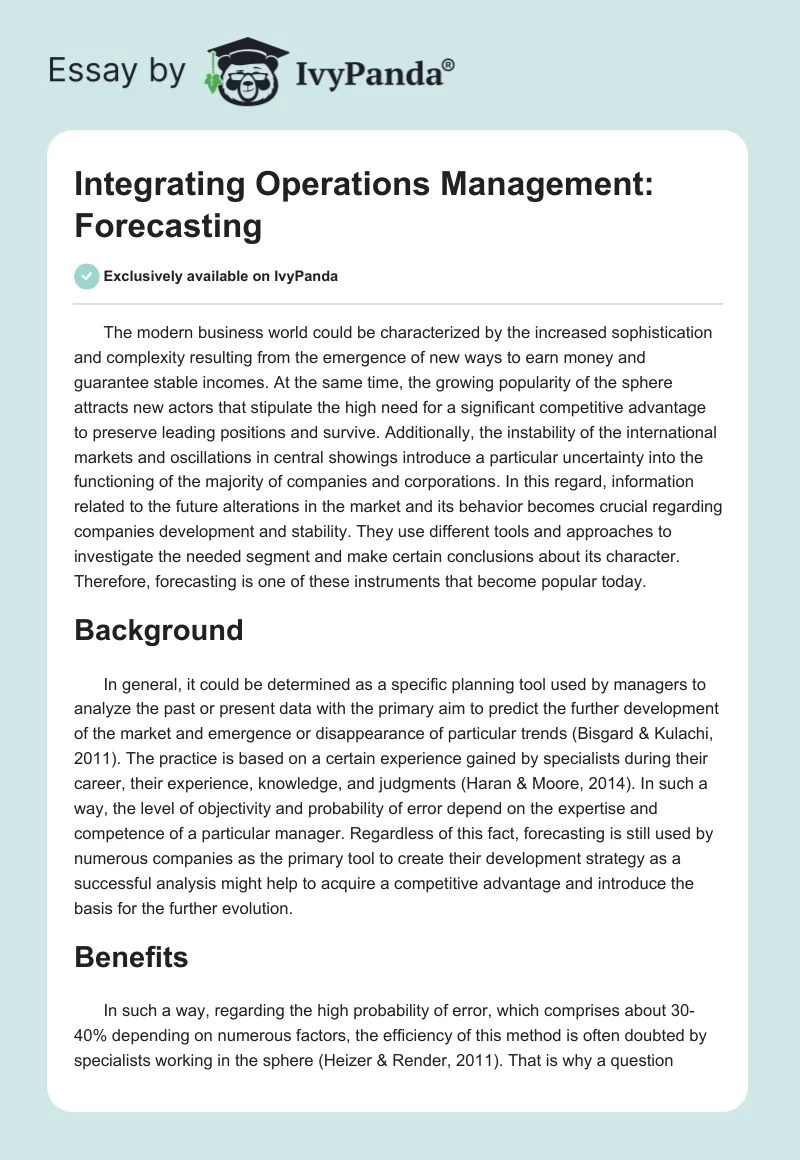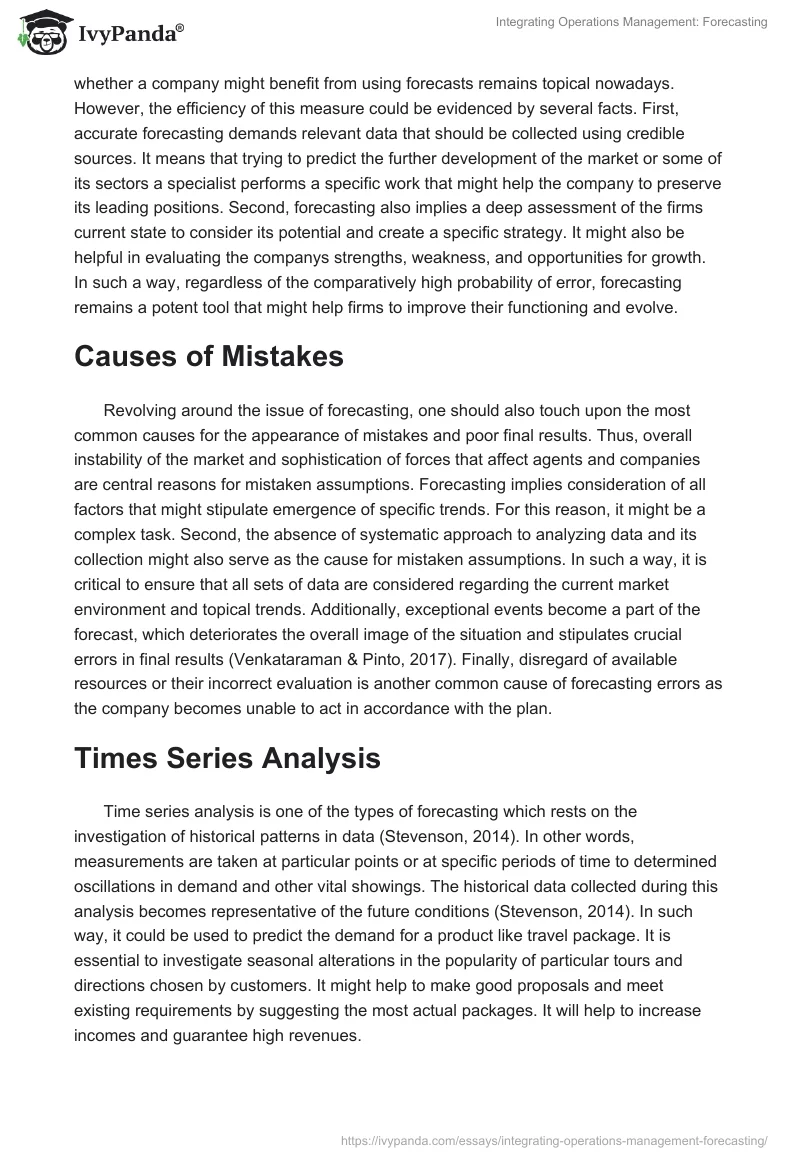The modern business world could be characterized by the increased sophistication and complexity resulting from the emergence of new ways to earn money and guarantee stable incomes. At the same time, the growing popularity of the sphere attracts new actors that stipulate the high need for a significant competitive advantage to preserve leading positions and survive. Additionally, the instability of the international markets and oscillations in central showings introduce a particular uncertainty into the functioning of the majority of companies and corporations. In this regard, information related to the future alterations in the market and its behavior becomes crucial regarding companies development and stability. They use different tools and approaches to investigate the needed segment and make certain conclusions about its character. Therefore, forecasting is one of these instruments that become popular today.
Background
In general, it could be determined as a specific planning tool used by managers to analyze the past or present data with the primary aim to predict the further development of the market and emergence or disappearance of particular trends (Bisgard & Kulachi, 2011). The practice is based on a certain experience gained by specialists during their career, their experience, knowledge, and judgments (Haran & Moore, 2014). In such a way, the level of objectivity and probability of error depend on the expertise and competence of a particular manager. Regardless of this fact, forecasting is still used by numerous companies as the primary tool to create their development strategy as a successful analysis might help to acquire a competitive advantage and introduce the basis for the further evolution.
Benefits
In such a way, regarding the high probability of error, which comprises about 30-40% depending on numerous factors, the efficiency of this method is often doubted by specialists working in the sphere (Heizer & Render, 2011). That is why a question whether a company might benefit from using forecasts remains topical nowadays. However, the efficiency of this measure could be evidenced by several facts. First, accurate forecasting demands relevant data that should be collected using credible sources. It means that trying to predict the further development of the market or some of its sectors a specialist performs a specific work that might help the company to preserve its leading positions. Second, forecasting also implies a deep assessment of the firms current state to consider its potential and create a specific strategy. It might also be helpful in evaluating the companys strengths, weakness, and opportunities for growth. In such a way, regardless of the comparatively high probability of error, forecasting remains a potent tool that might help firms to improve their functioning and evolve.
Causes of Mistakes
Revolving around the issue of forecasting, one should also touch upon the most common causes for the appearance of mistakes and poor final results. Thus, overall instability of the market and sophistication of forces that affect agents and companies are central reasons for mistaken assumptions. Forecasting implies consideration of all factors that might stipulate emergence of specific trends. For this reason, it might be a complex task. Second, the absence of systematic approach to analyzing data and its collection might also serve as the cause for mistaken assumptions. In such a way, it is critical to ensure that all sets of data are considered regarding the current market environment and topical trends. Additionally, exceptional events become a part of the forecast, which deteriorates the overall image of the situation and stipulates crucial errors in final results (Venkataraman & Pinto, 2017). Finally, disregard of available resources or their incorrect evaluation is another common cause of forecasting errors as the company becomes unable to act in accordance with the plan.
Times Series Analysis
Time series analysis is one of the types of forecasting which rests on the investigation of historical patterns in data (Stevenson, 2014). In other words, measurements are taken at particular points or at specific periods of time to determined oscillations in demand and other vital showings. The historical data collected during this analysis becomes representative of the future conditions (Stevenson, 2014). In such way, it could be used to predict the demand for a product like travel package. It is essential to investigate seasonal alterations in the popularity of particular tours and directions chosen by customers. It might help to make good proposals and meet existing requirements by suggesting the most actual packages. It will help to increase incomes and guarantee high revenues.
At the same time, time series analysis cannot be applied to all products and services because of the peculiarities of its use and data. As it has already been stated, historical data and information peculiar to certain time periods are collected. However, these might not be relevant regarding some sorts of products and services. For instance, time series analysis should not be explored when analyzing peculiarities of demand for different kitchen-stuff or pieces of food. The fact is that their distribution does not depend on seasonal changes as other causes might precondition alterations in demand. In such a way, this sort of analysis could hardly be applied to this product or situation.
JIT Approach
Nevertheless, numerous mistakes that might appear during the forecasting result in the appearance of diverse methods to alleviate the need for a highly accurate forecasting system. Just-in-time (JIT) approach is one of these measures. It could be defined as a strategy that presupposes a significant decrease of spending or waste by receiving goods or services only if they needed for the production process and are demanded by customers at this very moment (Reid & Sanders, 2015). One of the obvious advantages of this approach is that it helps to minimize mistakes in forecasting by producing or working with services that are needed now. In such a way, the probability of a mistake decreases and managers acquire an opportunity to create a comparatively accurate forecast that will help a company to evolve and remain prosperous.
Conclusion
Altogether, the modern business world is characterized by the increased sophistication and high level of rivalry. For this reason, managers use tools that help them to acquire a competitive advantage and guarantee the preservation of leading positions. Forecasting is of one these measures. It means the in-depth investigation of the market and tendencies affecting the business world. This demands outstanding competence, knowledge, skills, and expertise. At the same time, the probability of error remains high and comprises about 30-40%. However, even under these conditions, the company might still benefit from using this tool as it helps to assess the firms current state, discover its strong and weak aspects and collect data essential for its further evolution. Additionally, JIT approach might help to reduce the probability the number of mistakes and attain enhanced final results.
References
Bisgard, S., & Kulachi, M. (2011). Time series analysis and forecasting by example. Hoboken, NJ: Wiley.
Haran, U., & Moore, D. (2014). A better way to forecast. California Management Review, 57(1), 5-15. Web.
Heizer, J., & Render, B. (2011). Operations management. Flexible version. New York, NY: Pearson.
Reid, D., & Sanders, N. (2015). Operations management, binder ready version: An integrated approach. New York, NY: Wiley.
Stevenson, W. (2014). Operations management (McGraw-Hill series in operations and decision sciences). New York, NY: McGraw-Hill Education.
Venkataraman, R., & Pinto, J. (2017). Operations management: Managing global supply chains. New York, NY: SAGE Publications.


